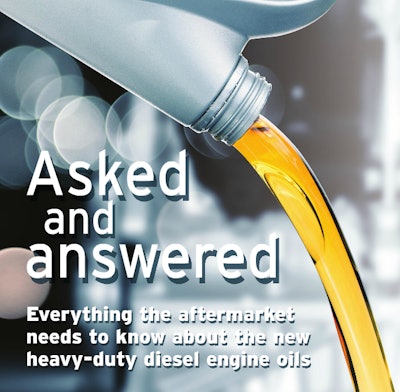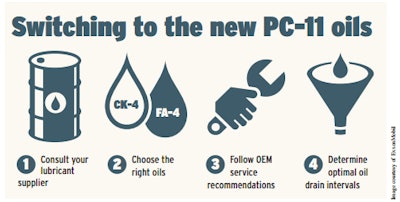The following comes from the July 2016 issue of Truck Parts & Service. To read a digital version of the magazine, please click the image below.

The North American medium- and heavy-duty trucking industry will receive an early Christmas present this year with the introduction of two new diesel engine oils, CK-4 and FA-4, on Dec. 1, 2016.
The new oils represent the first change to the heavy-duty diesel engine oil market in a decade, and the first time two new engine oils have been simultaneously released since 1994.
With changes like that, questions abound, and Truck Parts & Service has done its best to have as many as possible answered by the industry’s experts.
Why did trucking need new diesel engine oil?
The development of CK-4 and FA-4 can be traced back to 2010, when the Environmental Protection Agency (EPA) and National Highway Traffic Safety Administration (NHTSA) announced plans to introduce Federal regulations in the trucking industry to reduce greenhouse gas emissions and mandate fuel economy improvements.
In designing new technology to meet those future regulations, engine manufacturers determined the industry’s current oil (CJ-4) was falling short in some key areas and making it difficult for them to reach the proposed standards.
So they reached out to the oil industry for help.
“The engine manufacturers came to us. They wanted to propose a new standard,” says Kevin Ferrick, senior manager, Global Industry Services – Engine Oil at the American Petroleum Institute (API).
The Institute relayed the request to the ASTM International Heavy-Duty Engine Oil Classification Panel — API certifies new oil categories but it does not develop them — which accepted the manufacturers’ request and Proposed Category 11 (PC-11) was formed.
Who develops a new oil category?
All new diesel engine oil categories are developed through industry cooperation.
For PC-11, the task was given to the Heavy-Duty Engine Oil Classification Panel. Filled with engine OEM and oil marketer representatives and supported by API, the panel first met to address PC-11 nearly five years ago.
Chevron’s Jim McGeehan, then Shawn Whitacre (after McGeehan retired), handled the committee’s chairman duties.
Whitacre, Chevron’s senior staff engineer of engine oil technology, says early committee discussions focused on determining from OEMs the areas where the industry’s current oil was lacking, and the particular aspects that needed to be improved. Over time these issues were parsed into a few key needs — improved oxidation and shear stability, better aeration protection, lower viscosity grade products — and each representative returned to their respective companies for research and development.
It was during this time that API approved two manufacturer submitted tests to be used by oil marketers to meet the PC-11 performance requirements.
“We carry forward tests from each previous category. There weren’t a lot of new requirements,” says Ferrick.
How long does it take to develop a new oil?
As mentioned above, the new oils entering the market in December have been in the works for nearly five years. That time is split fairly evenly between category development, laboratory development and oil formulation, performance and on-road testing and then formal certification.
CK-4 and FA-4 are actually being released ahead of schedule. Early timelines had the oil entering the market in 2017, but requests from engine manufacturers to use the oil in model year 2017 engines motivated the development committee to finish production in 2016, says Dan Arcy, OEM technical manager at Shell.
API has no rules in place governing the length of development for new category, but does require a mandatory waiting period between when a proposed category is approved by committee and licensed for sale.
With CK-4 and FA-4 most oil marketers are using that time to continue validation and on-highway testing on their new products. Arcy says Shell has “more than 35 million miles” of highway testing on its new oils, and other oil marketers say they have significant miles of testing as well.
“We’re continuing to add more than 1.5 million miles each month with the help of select fleet partners,” says Paul Cigala, applications engineer, Commercial Vehicles at ExxonMobil.
How is the new oil different from the current oil?
This requires two very different answers, says Arcy.
“CK-4 is going to be a direct replacement for CJ-4. It will provide some additional benefits in those key areas [oxidation, aeration, shear stability] but it’s a direct replacement for what everyone is using today,” he says.
Where this new category so unique, and Arcy says differs from nearly every other diesel engine oil category released, is with FA-4.
“All FA-4 oils will be something W30,” he says. “They will have lower viscosity grades and be easier to pump.”
This was done specifically for engine manufacturers, Whitacre says.
By factory filling new 2017 engines will lower viscosity oils, engine manufacturers will be able to “maximize their fuel economy advantages with their new products,” he says.
“The reduction in greenhouse gas emissions comes from there,” Ferrick says. “Because the oil is lighter and easier to pump the engine doesn’t have to work as hard. And if the engine doesn’t work as hard it’s able to get better fuel economy, and better fuel economy leads to reduced emissions.”
Which oil will customers need?

Cigala says only CK-4 oils will be backwards compatible with all engines when released in December. FA-4 oils were designed specifically for model year 2017 engines and beyond, and are unlikely to be compatible with any previous model year technology, he says.
At press time for this article no engine manufacturers have announced which of their engines will be compatible with FA- 4. Oil marketers expect engine makers to begin announcing their plans in August, which will allow both sides enough time to communicate the information to their customers.
Each oil marketer says it will defer to OEM specifications as to which oils can be used in which engines. Oil marketers say distributors who cater to large fleets may want to stock some FA-4 for use in customers’ new vehicles, but say a heavy majority of oil sales will be the CK-4 product.
“There won’t be broad acceptance of FA-4 yet,” Whitacre says. “That may take a few years.”
When can I get this oil in stock?
Oil marketers are allowed to begin shipping CK-4 and FA-4 immediately after the new oils are licensed on December 1. It is likely that most will begin packaging the lubricant in the days leading up to that date so they can begin shipping the product as soon as legally possible.
“We want to get it out there quickly,” Arcy says.
Adds Cigala, “CK-4/FA-4 products will be available to our distribution network on or around the fi rst release date of December 2016, although it’s likely that owner-operators and fleets may not see the new diesel engine oils until early 2017.”
The key is in the packaging, Arcy says. Until CK-4 and FA-4 are licensed by API, they cannot be promoted or marketed as such.
Arcy says the backwards compatible CK-4 could be packaged and sold as CJ-4 as a means of getting the new product into the market sooner. FA-4 oil can only be packaged and sold as FA-4, and only after the licensing date.
Will customers like these new oils?
Oil marketers say CK-4 and FA-4 will both provide better performance and improve customer experiences.
“I think one thing we’ve been very impressed with is how robust the oxidation stability of these new oils are,” Whitacre says. “We put a lot of emphasis on that in development. Both oils really hold up well for longer periods of time due to the anti-oxidation features and that’s a benefit that will translate to any engine.”
Both new oils have been lauded in field testing for years, and have helped manufacturers only further design the products for maximum satisfaction, says Cigala.
“To date, the tests results and feedback from customers and OEM partners have helped advance our progress and demonstrate how CK-4 and FA-4 formulations will be able to deliver enhanced performance over today’s CJ-4 diesel engine oils.”

Ferrick says it’s hard to tell. “CJ-4 was around a long time,” he says. “But engines now have changed and evolved so much, other levels of protection may be needed.”
Even with the decision to move up the licensing date, some engine makers have indicated disappointment in the speed in which this category was developed. Ferrick says some of that can be attributed to the uniqueness of the dual category development, but says API will make expediency a top priority when any future categories are proposed.
And with additional rounds of EPA and NHTSA emission and fuel economy standards scheduled to be released through the next decade, it is possible OEMs will be calling for another category in just a few years.
Whitacre says the Heavy-Duty Engine Oil Classification Panel will be ready to go again whenever it is called upon.
“I think our hope is they hang around for a while. It would serve us well to have a reasonable lifetime to this standard,” he says.
But, he adds, “We’re realistic. As [Federal] regulations continue to get tighter and technology changes demands on engine oil are likely to become greater.”











